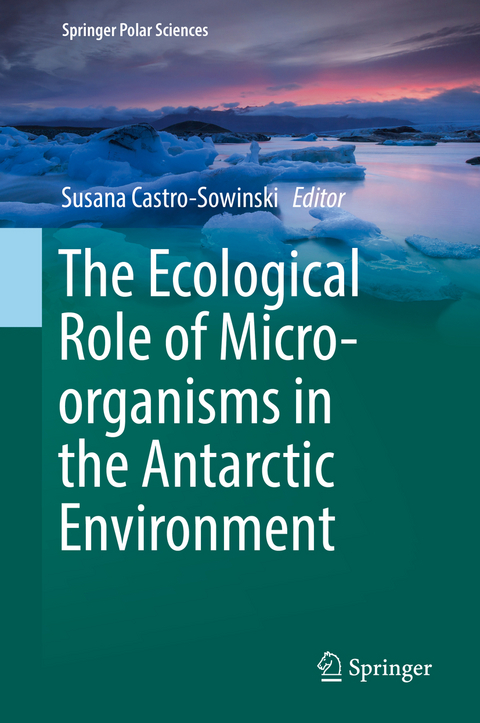
The Ecological Role of Micro-organisms in the Antarctic Environment
Springer International Publishing (Verlag)
978-3-030-02785-8 (ISBN)
This book provides up-to-date multidisciplinary information regarding microbial physiological groups in terms of their role in the Antarctic ecology. How do microorganisms shape the Antarctic environment? The book presents a thorough overview of the most important physiological microbial groups or microbial systems that shape the Antarctic environment. Each microbial model is described in terms of their physiology and metabolism, and their role in the Antarctic environmental sustainability. The individual chapters prepare readers for understanding the relevance of the microbial models from both an historical perspective, and considering the latest developments. This book will appeal to researchers and teachers interested in the Antarctic science, but also to students who want to understand the role of microbes in the ecology of extreme environments.
Dr. Susana Castro-Sowinski is Ph.D. in Chemistry and has completed her academic training at the Department of Plant Pathology and Microbiology, Robert Smith Faculty of Agriculture, Food and Environment in Rehovot, Israel. Currently, she is Associate Professor at the Biochemistry and Molecular Biology Section, Faculty of Sciences, Universidad de la República, in Montevideo, Uruguay, and member of the Researcher National System (SNI), the Program for Developing Basic Sciences (PEDECIBA) and the Editorial Board of Symbiosis (Springer) and Environmental Sustainability (Springer). Her specific area of research has been the molecular-plant microbe interaction, but currently, she is exploring a new area of research, focusing her work on the microbial ecology of Antarctic systems and the development of biotechnological products using the genetic material of Antarctic microorganisms. Professor Castro-Sowinski has 40 research papers published in international journals, six book chapters and has edited one book. She has tutored many postgraduate students in the areas of the potential use of microorganisms in the development of the biotechnological application. She also teaches biochemistry and biotechnology for graduate students in three different courses (Biochemistry, Introductory Course to Antarctic Research and Antarctic Summer School; Faculty of Sciences, Universidad de la República).
Part I: The role of microorganisms in the biogeochemical cycles in Antarctica.- Chapter 1. Role of Cyanobacteria in the ecology of different polar environments (Marc W. Van Goethem and Don A. Cowan).- Chapter 2. Patterns of microorganisms inhabiting Antarctic freshwater lakes with special reference to aquatic moss pillars (Ryosuke Nakai, Satoshi Imura and Takeshi Naganuma).- Chapter 3. Yeast activities involved in carbon and nitrogen cycles in Antarctica (Silvana Vero, Gabriela Garmendia, Adalgisa Martínez-Silveira, Ivana Cavello and Michael Wisniewski).- Chapter 4. Living with pigments: the colour palette of Antarctic life (Juan José Marizcurrena, Fernanda Cerdá, Diego Alem and Susana Castro-Sowinski).- Part II: Invasive colonization and human perturbations in Antarctic microbial ecosystems.- Chapter 5. Horizontal Gene Transfer Elements: Plasmids in Antarctic Microorganisms (Matías Giménez, Gastón Azziz, Paul R. Gill and Silvia Batista).- Chapter 6. Diversity and ecological roles of prokaryotes in the changing Antarctic marine environment (Angelina Lo Giudice and Maurizio Azzaro).- Chapter 7. Antarctic Soil Microbial Communities in a Changing Environment: Their Contributions to the Sustainability of Antarctic Ecosystems and the Bioremediation of Anthropogenic Pollution (Cecilia G. Flocco, Walter P. Mac Cormack and Kornelia Smalla).- Chapter 8. Airborne Microorganisms in Antarctica: Transport, Survival and Establishment (Katie King-Miaow, Kevin Lee, Teruya Maki, Donnabella LaCap-Bugler and Stephen David James Archer).- Chapter 9. Molecular biology of RNA viruses isolated in Antarctica (Juan Cristina).- Part III: The ecological roles of microorganisms inhabiting specific Antarctic niches.- Chapter 10. The hidden life of Antarctic rocks (Vanesa Amarelle, Valentina Carrasco and Elena Fabiano).- Chapter 11. Marine fungi associated with Antarctic macroalgae (Mayara B. Ogaki, Maria T. de Paula, Daniele Ruas, Franciane M. Pellizzari, César X. García-Laviña and Luiz H. Rosa).- Chapter 12. Microbial role in the ecology of Antarctic plants (Júnia Schultz and Alexandre Soares Rosado).- Chapter 13. Microbial symbionts of Antarctic marine benthic invertebrates (Angelina Lo Giudice, Maurizio Azzaro and Stefano Schiaparelli).
| Erscheinungsdatum | 31.01.2019 |
|---|---|
| Reihe/Serie | Springer Polar Sciences |
| Zusatzinfo | XV, 298 p. 68 illus., 55 illus. in color. |
| Verlagsort | Cham |
| Sprache | englisch |
| Maße | 155 x 235 mm |
| Gewicht | 652 g |
| Themenwelt | Naturwissenschaften ► Biologie ► Mikrobiologie / Immunologie |
| Naturwissenschaften ► Biologie ► Ökologie / Naturschutz | |
| Naturwissenschaften ► Geowissenschaften ► Meteorologie / Klimatologie | |
| Schlagworte | Antarctic microbes and microbial ecology • Climate change impacts • microbial drivers in Antarctic aquatic environment • microbial drivers in Antarctic aquatic environments • Microbial ecology of Antarctic aquatic systems • microbial physiological groups • Nutrient cycling in the Antarctic • physiological groups of bacteria • Physiology and metabolism of microbes • Role of Antarctic bacteria/cynobacteria • Trophic ecology in extreme environments |
| ISBN-10 | 3-030-02785-6 / 3030027856 |
| ISBN-13 | 978-3-030-02785-8 / 9783030027858 |
| Zustand | Neuware |
| Haben Sie eine Frage zum Produkt? |
aus dem Bereich


